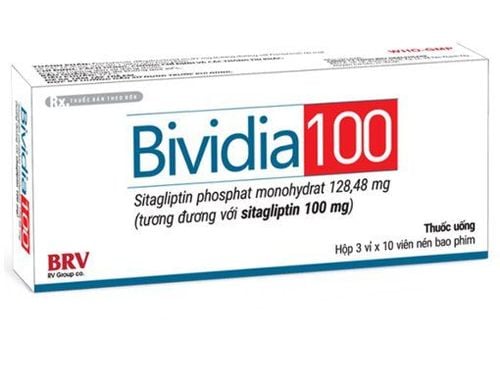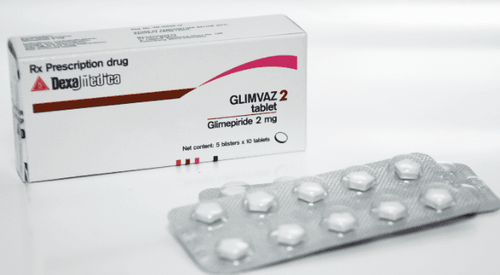This is an automatically translated article.
Alogliptin is used to support blood sugar balance in patients with diabetes. The drug is used in conjunction with a daily diet and exercise routine. However, the drug can cause some side effects such as shaking, sweating, heart palpitations, etc. Therefore, patients need to carefully study the drug information and consult a doctor before using it. use.1. Mechanism of action of the drug Alogliptin
Peak inhibition of the DPP-4 component of Alogliptin occurred within 2-3 hours of a single dose in healthy subjects. Maximum inhibition of DPP-4 exceeded 93% at doses of 12.5 mg to 800 mg. DPP-4 inhibition remained above 80% after 24 hours with larger doses or 25 mg of Alogliptin. Alogliptin also demonstrated a decrease in glucagon while increasing active GLP-1 levels compared with placebo over a standard 8-hour postprandial period.
Alogliptin inhibits dipeptidyl peptidase 4 (DPP-4), and degrades glucose-dependent insulinotropic polypeptides (GIP) and glucagon such as peptide 1 (GLP-1). DPP-4 inhibition increases the amount of active plasma incretin that helps control blood glucose. GIP and GLP-1 stimulate glucose-dependent insulin secretion in pancreatic beta cells. GLP-1 additionally inhibits glucose-dependent glucagon secretion, induces satiety, and reduces food intake and gastric emptying.
2. Uses of the drug Alogliptin
Alogliptin is effective in controlling blood sugar in people with diabetes. The effect of the drug is only effective when it is combined with a reasonable diet and exercise. Controlling blood sugar levels will help prevent complications of diabetes, including organ damage such as kidneys, blindness, nerve problems, etc. Moreover, Alogliptin also works. used to reduce the risk of heart attack or stroke.
Alogliptin works by increasing levels of incretin, which helps control blood sugar by enhancing insulin release, especially after meals. Alogliptin also reduces the amount of sugar produced by the liver.
3. Dosage and how to use Alogliptin
Alogliptin is prescribed once a day and taken with meals. Therefore, the patient should take the medicine at the same time of day. Furthermore, patients need to adhere to a diabetes management regimen with medication, a reasonable diet, and exercise.
The dose indicated for drug use depends on the patient's health condition and response to treatment. Therefore, patients should use the drug regularly to get results. In addition, the doctor has the facility to monitor and adjust the patient as well as the exercise program and develop a suitable diet.
4. Unwanted side effects when using Alogliptin Alogliptin medicine can cause some common side effects such as joint pain, unusual blisters on the skin, signs of heart failure, shortness of breath, swollen ankles. and feet, sudden or unexplained weight gain...
Alogliptin alone does not cause hypoglycemia, but is prescribed with other diabetes medications to do this.
While using Alogliptin for treatment, if patients experience symptoms of hypoglycemia, they can take glucose tablets or gels, eat sweet foods such as sugar, honey, drink fruit juices or You can talk to your doctor about the side effects you're experiencing.
Hypoglycemia is more likely to occur if the person drinks a lot of alcohol and does intense exercise or eats little. To prevent this, the patient should eat meals according to the set schedule. Besides, patients experience side effects of hyperglycemia such as thirst, increased urination, confusion, drowsiness... If these symptoms occur, the patient should report to the doctor to adjust whether treatment course. Besides, the patient must be taken to the hospital immediately if the following situations occur:
Signs of pancreatitis such as loss of appetite, stomach pain, back pain, nausea and vomiting that do not stop; Dark urine or yellowing of the eyes and skin; Rash, swelling, itching of the face, tongue, and neck; Shortness of breath, dizziness... Measures to prevent unwanted side effects when using Alogliptin:
Before using Alogliptin, it is necessary to discuss with your doctor whether the patient has an allergic reaction to the drug or not. , and exchange information about medical history, especially kidney disease, heart failure, liver problems, pancreas,...; Blurred vision, dizziness, or drowsiness due to low or high blood sugar may occur. Therefore, if the patient is in the course of treatment with Alogliptin, they should not use machines or drive a car,... to ensure safety; Patients should limit alcohol use if they are being treated with Alogliptin because alcohol can increase the risk of hypoglycemia; When the body is stressed due to fever, infection, injury or surgery, blood sugar levels are difficult to control. Therefore, the patient should consult a doctor to adjust the treatment plan; Whether Alogliptin can pass into breast milk has not been proven to date. However, pregnant and lactating women should carefully weigh the benefits and risks before using the drug. 5. Some notes when using Alogliptin Alogliptin can be effective if the patient pays attention to the following points:
Do not use Alogliptin with other drugs; Participate in diabetes knowledge education sessions to improve knowledge on how to control the disease with drugs, diet, and exercise; Learn about blood sugar symptoms and treatments and check your blood sugar regularly. Alogliptin interaction is possible with beta-blockers, which prevent tachycardia or tachycardia during hypoglycemia. Other symptoms of hypoglycemia such as dizziness, sweating... are not affected by these drugs.
Please dial HOTLINE for more information or register for an appointment HERE. Download MyVinmec app to make appointments faster and to manage your bookings easily.
Reference source: drugs.com













